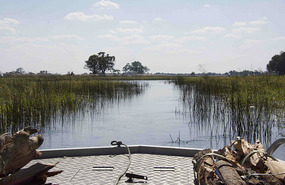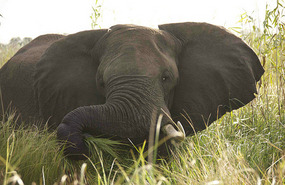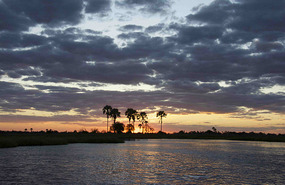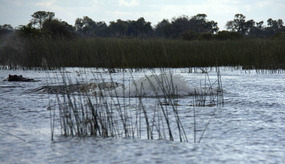After the fantastic experience of Savuti National Park, we were now heading off to Maun, some six hours south west and the world famous Okavango Delta. During the planning stage of this trip, it was obvious due to financial and time constraints that we could not hope to do a safari everywhere in the region. So I had chosen Savuti National Park as our dry land Safari, the Okavango Delta as the wetland area and Etosha as the desert area. These being the main three destinations, if time allowed I was also keen to see the birds in the Okavango Panhandle and Dad was keen to view Wild Dogs (if possible) probably in Namibia.
With these plans, it was Douwe Volk (we met in Nata) who suggested contacting Okavango Still in Maun to organise the Delta part of our trip
. This he suggested would be a waterborne safari, camping on one of the remote islands in the famous Moremi National Park which is right in the centre of the Delta. These recommendations we ended up following and the trip was booked.
The six hour trip from Kesane, unfortunately retracing our route back to Nata before heading due west to Maun along the northern banks of the salt pans was quite literally, monotonous. It was a relief to enter Maun, which was at least four times the size of Kesane. It was obviously a boom town with many ex-pats, building works spreading out along the shores of the Delta and a booming tourist industry.
We decided to camp at the Island Safari Lodge, a camp site adjacent to the resort and right on the shores of the Delta. Electric fences protected our tents from the crocodiles. The camp site was nice enough, the showers hot, but the staff (especially in the restaurant and bar) were surly and quite frankly disinterested
. The worst problem occurred during the England Vs Uruguay World Cup match when (after saying we could watch the match) the staff decided to turn off the TV at half time and close the bar. After a heated debate, the decision was reversed by a manager in his office who refused to come out and discuss his decision with us, the paying customers.
It was therefore great to find a fantastic cafe with delicious home cooked food run by an ex-pat called Hilary. Hilary’s Cafe was a joy, with home made bread and muffins, fabulous salads and other dishes far removed from the normal piles of fried meat that appear to be the staples of cuisine in this region. Hilary herself was a lovely person, well integrated into the local community and a mine of useful information. We also meet Paul, an American who had a printing company making National Park maps and also re-printing historical maps of Africa going back to the 17th Century. Dad was well impressed with his work
.
After a couple of days rest, when I badly hurt my back, it was off again on our Delta Safari. This time we were in an aluminium boat with seven seats and a huge outboard motor. Our team for this trip was lead by our guide Keone, a huge former rugby player who was half Angolan and raised in the Maun area. Our chef was a friendly man called Frog (well that was his nickname, due to his goalkeeping ability) and he turned out to be a multi-talented chef. Finally we had Daniel, a member of the Herero tribe from the western part of the Delta. He was a friend of the owner of Okavango Still, Richard and was to be the camp assistant. Off we went.
The Okavango Delta is 18,000 square kilometres in size and the water ways spread down from Angola like an eagle’s talons. The water which falls in Angola never makes it to the sea, but seeps into the land or runs into the salt pans to the west of Nata
. The sheer size and scale of the delta is amazing and its home to many sandy islands, birds and animals. The water itself is pure rainwater and very clear. The tributaries snake through gigantic reed beds and are sandy. Some are very wide, some are very narrow. The animals live mostly on these secluded islands that make up the Delta and spend many days moving from island to island. The most astounding thing about these waterways is the strength of the currents, making navigation difficult. The reeds complicate this further clogging up the outboard engines and they are only kept completely clear by the movements of hippos and elephants.
It was into this unique environment that Keone piloted the boat. Sometimes the sand banks were clearly visible underneath the water, sometimes the lanes were so narrow that the boat hardly fitted in amongst the towering elephant grass and many times we got stuck. Keone spent a quite while over the next four days unblocking the engine. Within a few kilometres of leaving the mooring area in Maun, we had seen the Giant Kingfishers I had asked to see, so that was great. After a four hour trip through the increasingly narrow lanes of the southern part of the Delta, we crossed into the Moremi National Park and made contact with Chief’s Island. Here was to be our camp and Frog and Dan immediately set about getting it set up. Keone decided to take us north a bit further to see the sun set and other animals around the Moremi Crossing and Gunn Camps. The bird life in this part of the Delta was prolific, with many Jacanda, Pied and Malachite Kingfisher and a huge number of Fish Eagles. The animals were somewhat more shy, but the sunset was dramatic with amazing reflections on the water.
Back at camp we were treated like we were staying in a five star hotel. The tents were cosy, head height with full beds and linen. Wash basins were outside, as was the toilet and the shower. We had a fire (kitchen) and dinning table each overlooking a large fresh water lagoon which at night resonated to booming noises of the hippos. “They all come out of the water at night to search for grazing food” mentioned Keone. That made me wonder whether they would be coming through our camp. “No worries, the fire keeps all the animals away, but don't go to the toilet alone at night,” he added. Over the course of the next few nights the noises at night were incredible and on the second night we were treated to at least two male lions roaring at each other, “probably about five and three kilometres away” estimated Keone (to my relief). These roars were loud and mesmerising and certainly made you contemplate your place in the food chain. The hippos also made a lot of noise on their return to the lagoon at dawn . The sound of their characteristic chuckle was only matched by the African Dove’s call of “work harder, work harder, work harder,” as the sun rose in the sky.
The quality of Frog’s food was astounding. He had brought along his own handmade oven, in which he baked bread, roasted beef and chicken plus other delicacies. He bought all the food for the trip himself, ensuring the quality was there and never once did we have anything substandard. After the lacklustre food at Island Safari Camp in Maun, this was a most welcome change, and it was all cooked on the one fire. Dan himself was always ready and willing to help with everything and a very nice and amiable guy as well. Keone was a good guide and I never felt he was taking liberties with our safety. He was also fully tuned in to what Dad and I wanted to see and how to facilitate that. We had given him a list of birds plus an idea of what animals we wished to see and if possible in certain situations.
Nevertheless, in spite of our early good luck with the Giant Kingfishers, the first full day of Safaris really only delivered birds. I never expected to see huge concentrations of animals, like those we had witnessed in Savuti, but it was unfortunate not to see anything larger than a Fish Eagle. We stopped at a sand island for a packed lunch and bumped into two Germans with their guides. They were most disappointed about the lack of animals they had seen, but Keone just dismissed their complaints saying that as they were heading back to their lodge for lunch they were going to miss the best viewing time.
On this island after lunch, he led us off on one of our first of three walks. A walking safari was something I had been determined to do, so this was great. However, whereas the walking safari in Kazaranga in NE India was with an armed guard of three soldiers, on this particular walk, Keone just took a stick. If we come across a lion, “you must stay in single file, not move and maintain eye contact for as long as it takes for the lion to leave. Running, any movement or a loss of eye contact will be the last thing you ever do.” Well that was pretty clear I thought.
As it happened we came across Kudu, Lechwe and Impala antelopes, plenty of Warthogs (unfortunately only in the distance), vultures and other birds. The subsequent two other walks we undertook with Keone obviously took on a more of an adrenaline rush, the mornings after we heard the roaring male lions during the night. Dad throughly enjoyed these excursions despite his obvious discomfort in plus 25C temperatures.
At night it was always a pleasure to return to the lantern lit camp, where fresh shower water had been heated, dinner was ready and fires were blazing to keep the night time temperatures and unwanted visitors at bay. Unfortunately at the end of this first day, my back injury was extremely painful and I realised that I would have to seek some treatment in Maun on our return.
It was actually on the second day that we had our greatest experience of animals, in a sort of close encounters type of way. On this day, Keone piloted us quite far into the Delta, to an area where only one flyin (airplane accessible) camp was located, called the “Odd Ball Camp.” Here after another walking safari (curtailed due to my back pain) and some boat engine trouble in the morning, we eventually reached the Odd Ball area in the early afternoon. As soon as we arrived we witnessed some spectacular events which included, many groups of elephants crossing the waterways, some only meters from the boat. We also were lucky to witness two males clashing (in the distance - not a full bloodied encounter according to Keone) plus one male shaking a palm tree to access the fruit (a rare sight - Keone). On our way to a lagoon where we planned to have lunch, we surprised three hippos, a male, female and tiny baby. They crashed at speed through the lagoon to escape the boat with the baby setting a spectacular pace. However after they obviously felt more secure, the male peeled off and charged the boat. For a split second we were concerned, especially after the earlier engine trouble. The speed of the charge through the water was also alarming, and the mini tsunami in front of the angry animal was very threatening. But it was a relief to see Keone smiling as he powered up the engine and we left the hippo far behind at the entrance to the lagoon. More people are killed by hippos in Africa than any other animal, and after witnessing their speed, I was full of respect. My father was as white as a sheet. His blood sugar level was instantly enhanced by a beer for lunch at the end of a neighbouring lagoon, and then a nice walk where we stumbled on some beautiful baobab trees and a large water monitor.
Back in the boat and back into the lagoon where we had left the psychotic hippo was slightly nerve racking and even more so when we saw him blocking the exit. Obviously like elephants they don't forget, but Keone just opened the throttle and we cruised past at high speed. “They are weary of the propellers,” he added.
Now we had to return to camp at speed and winding our way through the narrow waterways this fast was exhilarating. Kingfishers were everywhere as were the beautiful JC birds, the Jacana. We spotted giraffe in a distant channel plus a substantial herd of buffalo. We also came across more water borne elephants and another highly grumpy hippo who was again threatening and blocked our escape route from his lagoon. However, when he heard the boat at full throttle he too disappeared.
The last encounter was on a narrow waterway at a tight corner when we came across a solitary young male elephant crossing the channel. He was knee deep and when we approached he started waving his head and flapping his ears in most aggressive way. Keone held his position in the channel and soon the elephant roared, raised his tusks and charged at us. This was impressive, but not as fast as the hippo, but a little un-nerving nevertheless. Keone again roared his motor, and the elephant stopped. He then opened the throttle whereupon the elegant turned and fled into the reeds. Dad seemed more relaxed about this encounter.
We managed to beat the sunset, and witnessed some great reflections. We enjoyed a wonderful last meal with the guys and the next day it was an early pack. Keone took us into the reed beds to see the Malachite Kingfisher and then we had to leave back to Maun. This was another truly memorable safari and a great all round experience.
Charging Hippos, Delta, Glamping & Roaring Lions
Wednesday, June 25, 2014
 Maun, Botswana
Maun, Botswana
Other Entries
-
43Lip Plates, Mursi, Mingi Children & Bad 4x4s
Mar 05112 days prior Jinka, Ethiopiaphoto_camera4videocam 0comment 0
Jinka, Ethiopiaphoto_camera4videocam 0comment 0 -
44Hamar, markets, clothes and free beer (not for me)
Mar 08109 days prior Turmi, Ethiopiaphoto_camera4videocam 0comment 0
Turmi, Ethiopiaphoto_camera4videocam 0comment 0 -
45Bull Jumping, Whipping, Wiggly Canoes, Addis Rain
Mar 17100 days prior Johannesburg, South Africaphoto_camera6videocam 0comment 4
Johannesburg, South Africaphoto_camera6videocam 0comment 4 -
46Family, Food, the Cape and Animals
Apr 0185 days prior Fish Hoek, South Africaphoto_camera4videocam 0comment 0
Fish Hoek, South Africaphoto_camera4videocam 0comment 0 -
47Baguettes, Renault 4s and a little bit of France
Apr 0977 days prior Antananarivo, Madagascarphoto_camera2videocam 0comment 0
Antananarivo, Madagascarphoto_camera2videocam 0comment 0 -
48Indri, Chameleons, Weevils, Frogs and Night Safari
Apr 1274 days prior Andasibe, Madagascarphoto_camera6videocam 0comment 0
Andasibe, Madagascarphoto_camera6videocam 0comment 0 -
49Air Mad, Rain, Leeches, Trekking, Jungles
Apr 1868 days prior Sambava, Madagascarphoto_camera6videocam 0comment 0
Sambava, Madagascarphoto_camera6videocam 0comment 0 -
50Sifakas, Pygmy Kingfishers, Maroujejy NP Part 2
Apr 2165 days prior Manantenina, Madagascarphoto_camera6videocam 0comment 0
Manantenina, Madagascarphoto_camera6videocam 0comment 0 -
51Cream sauces, paradise, sandy beaches, wildlife
Apr 2759 days prior Diego Suarez, Madagascarphoto_camera5videocam 0comment 0
Diego Suarez, Madagascarphoto_camera5videocam 0comment 0 -
52Tsingy Rouge, Lemurs, Corruption, Air Madagascar
May 0155 days prior Joffreville, Madagascarphoto_camera5videocam 0comment 0
Joffreville, Madagascarphoto_camera5videocam 0comment 0 -
53Glamping, Nat Parks, Dew, Blood & Gooners
May 2234 days prior Swellendam, South Africaphoto_camera5videocam 0comment 0
Swellendam, South Africaphoto_camera5videocam 0comment 0 -
54Big Holes, Shut Attractions, Bush, Endless Roads
May 3026 days prior Kimberley, South Africaphoto_camera4videocam 0comment 0
Kimberley, South Africaphoto_camera4videocam 0comment 0 -
55Fires, Towing and the Kindness of Strangers
Jun 0124 days prior Gaborone, Botswanaphoto_camera1videocam 0comment 0
Gaborone, Botswanaphoto_camera1videocam 0comment 0 -
56Auto Parts, Nata Birds, Wind and Elephants
Jun 0619 days prior Francistown, Botswanaphoto_camera3videocam 0comment 0
Francistown, Botswanaphoto_camera3videocam 0comment 0 -
57Water, Rivers, Camping, Customs and Getting Wet
Jun 1015 days prior Victoria Falls, Zimbabwephoto_camera5videocam 0comment 0
Victoria Falls, Zimbabwephoto_camera5videocam 0comment 0 -
58Sand, Hides, Elephants, Birding, getting Stuck
Jun 1510 days prior Kasane, Botswanaphoto_camera7videocam 0comment 0
Kasane, Botswanaphoto_camera7videocam 0comment 0 -
59Safari, Glamping, Sand & Wildlife
Jun 205 days prior Savuti National Park, Botswanaphoto_camera4videocam 0comment 0
Savuti National Park, Botswanaphoto_camera4videocam 0comment 0 -
60Charging Hippos, Delta, Glamping & Roaring Lions
Jun 25 Maun, Botswanaphoto_camera4videocam 0comment 0
Maun, Botswanaphoto_camera4videocam 0comment 0 -
61Creationists, Rare Birds, Rock Art & Meteorites
Jun 283 days later Rundu, Namibiaphoto_camera5videocam 0comment 0
Rundu, Namibiaphoto_camera5videocam 0comment 0 -
62Bushmen, Hunts, the San, Gravel Roads, Car Trouble
Jul 049 days later Tsumkwe, Namibiaphoto_camera8videocam 0comment 0
Tsumkwe, Namibiaphoto_camera8videocam 0comment 0 -
63Animals, waterholes, dust, more dust
Jul 1015 days later Etosha National Park, Namibiaphoto_camera4videocam 0comment 0
Etosha National Park, Namibiaphoto_camera4videocam 0comment 0 -
64Fog, concrete, sand, cold, wind plus illness
Jul 1722 days later Walvis Bay, Namibiaphoto_camera5videocam 0comment 0
Walvis Bay, Namibiaphoto_camera5videocam 0comment 0 -
65Red Dunes, Mud Flats, Quiver Trees plus Sand
Jul 2328 days later Keetmanshoop, Namibiaphoto_camera5videocam 0comment 0
Keetmanshoop, Namibiaphoto_camera5videocam 0comment 0 -
66Breaching Sharks, Rooibos and Rain
Aug 0137 days later Vanrhynsdorp, South Africaphoto_camera4videocam 0comment 0
Vanrhynsdorp, South Africaphoto_camera4videocam 0comment 0 -
67Robbery, Raw Fish, Cloudy and Drizzle
Aug 0541 days later Lima, Peruphoto_camera4videocam 0comment 0
Lima, Peruphoto_camera4videocam 0comment 0 -
68Camille Schaeffer and Family RIP
Aug 1147 days later Lima, Peruphoto_camera1videocam 0comment 0
Lima, Peruphoto_camera1videocam 0comment 0 -
69Rest, Lines, Vines and Sand
Aug 1248 days later Ica, Peruphoto_camera4videocam 0comment 0
Ica, Peruphoto_camera4videocam 0comment 0 -
70Incas, Ruins, Trains, Parasites, Veganism
Aug 1955 days later Cusco, Peruphoto_camera4videocam 0comment 2
Cusco, Peruphoto_camera4videocam 0comment 2 -
71Cloud Forest, Ruins, Birds, Animals, 50th
Aug 2460 days later Manu National Park, Peruphoto_camera5videocam 0comment 0
Manu National Park, Peruphoto_camera5videocam 0comment 0 -
7250th part 2, Otters, Macaws, Jaguar, Tiramisu
Aug 3066 days later Puerto Maldonado, Peruphoto_camera6videocam 0comment 0
Puerto Maldonado, Peruphoto_camera6videocam 0comment 0 -
73Finches, Volcanos, Tortoises & Darwin
Sep 0370 days later Puerto Ayora, Ecuadorphoto_camera7videocam 0comment 0
Puerto Ayora, Ecuadorphoto_camera7videocam 0comment 0 -
74Sharks, Penguins, Sea Lions and Boobys
Sep 1077 days later Puerto Villamil, Ecuadorphoto_camera6videocam 0comment 0
Puerto Villamil, Ecuadorphoto_camera6videocam 0comment 0 -
75Frigates, Poor Service, Iguanas, Diving Pelicans
Sep 1380 days later Guayaquil, Ecuadorphoto_camera5videocam 0comment 0
Guayaquil, Ecuadorphoto_camera5videocam 0comment 0 -
76Car Crash, Chachas, Mules and Blood
Sep 1885 days later Chachapoyas, Peruphoto_camera4videocam 0comment 0
Chachapoyas, Peruphoto_camera4videocam 0comment 0 -
77Kuelap, Mummies, Ruins, Hummingbirds
Sep 2592 days later Leymebamba, Peruphoto_camera6videocam 0comment 0
Leymebamba, Peruphoto_camera6videocam 0comment 0 -
78Sarcophagi, Fountains of Blood, Horseback
Sep 2895 days later Cuispes, Peruphoto_camera3videocam 0comment 0
Cuispes, Peruphoto_camera3videocam 0comment 0

 Maun, Botswana
Maun, Botswana











2025-05-22